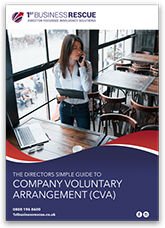If your business is suffering cash flow problems, you may have been forced into a situation where you are spending more time dealing with pressure from creditors than concentrating on running your business. In this scenario, a Company Voluntary Arrangement could be the perfect solution to your company’s problems.
After many years of working with CVA’s we find that they are more beneficial in certain sectors that have licenses and accreditations to protect. For example, hauliers must protect their VOSA license and similarly nursing agencies with the CQC.
CVA’s in most cases are approved and accepted by licensing and governing bodies, we can advise on your specific circumstances.
Company Voluntary Arrangements are sometimes referred to as Voluntary Arrangements or shortened to just CVA. But what does a CVA mean in business? They help by reducing the company’s monthly payments and removing creditor pressure, which leaves the directors to focus on returning the company to solvency.
What is a CVA
Where to Begin?
If your company is facing financial difficulty, there can be many different reasons. Sometimes, it could be a short-term cash flow issue. In other cases, it might be that the business has been burdened by historical debts, which hinder its ability to thrive. To overcome these financial difficulties, the company can take one of several options. As there are so many available, it is advisable to speak with an expert in this field to help you properly navigate your way through the company’s challenges.
A CVA is a Company Voluntary Arrangement and is an option for companies in financial difficulty that could lead to insolvency. It is a legally binding agreement with the company’s creditors to allow a proportion of debts to be repaid over a specified period.
75% of the creditors by value must agree to this process, and if so, it can be one of the best ways for a business to recover and thrive after being burdened by historic debt. A CVA is like an IVA used by those who have personal debt. It will allow the company to repay the specified proportion of its debts over 1 to 5 years.
CVAs were introduced to UK law in 1986 and are generally preferred by the government to save a company from closure.
What Companies are Eligible for a CVA
CVAs can be extremely useful for limited companies which find themselves with mounting debts that they are struggling to repay and, therefore, are facing insolvency. It is also often the case that the debts might be historical and are holding the company back from thriving when it would otherwise be a going concern.
You may apply for a CVA under the following circumstances:
- The company is currently insolvent
- An insolvency practitioner has determined that the business is still viable despite its current difficulties
If the latter, the company must demonstrate that it will be able to repay creditors plus honor other obligations such as salaries and VAT and still remain profitable in the future.
Is administration and a CVA the same thing?
No, a CVA is different from company administration. CVAs take place before insolvency, whereas a viable company that has become insolvent would go into administration. A CVA is undertaken to avoid insolvency. Throughout a CVA, the Directors maintain control of the company, whereas the insolvency practitioner will take control in administration.
What is the process for a CVA?
A CVA process typically takes in the region of seven to ten weeks, and there are various stages to it. They include:
- The appointment of an expert adviser such as an insolvency practitioner (IP) will assist in drafting a proposal for the creditors. However, there should be no significant changes to the company’s debt status throughout this period, and suppliers should continue to be paid, however possible.
- A full review of the business will be conducted of all the elements of the company, beyond the finances. These include the people and the market and will enable creditors to decide whether or not to support the deal when offered.
- The draft proposal undergoes a period of review by the directors in the first instance, and it must be agreed that it is to the creditors’ benefit. At this point, it could be decided that it would be better to close the business instead.
- The proposal is distributed to the creditors, and a meeting would be called for them to voice any concerns or ask any questions. Creditors will need to vote, and at least 75% (of the value of the debt) must agree for the CVA to be approved.
- A further meeting of the connected creditors will then take place (e.g., employees or directors), and 50% of these must also agree to the proposal.
- A report will be generated by the IP to detail the information in the proposal and the outcome of the votes etc., and this will be submitted to the court.
- The CVA will then be launched, and the agreed repayments will need to start. The debts are repaid via the IP, and the company is protected as long as there are no defaults on the repayments. If they do default, it might force compulsory liquidation.
Need help with your CVA?
What is included within a CVA proposal?
Elements of the proposal will include:
- The backstory as to how the company has come to be in this position
- A true reflection of the company’s financial position, including the value of the assets, all liabilities, any 3rd party property
- Cash flow forecasts, which will demonstrate how much the company is likely to be able to repay each month
- How long the CVA is scheduled to last, plus any expenses that are to be incurred
- How the money repaid is to be used
- Reasons the creditors should agree to the CVA including evidence that it will be preferable long-term for the creditor as opposed to liquidation
If the proposal is not agreed upon, a Creditors’ Voluntary Liquidation process might need to be considered. Alternatively, the creditors may launch a winding up petition to force compulsory liquidation.
How long will a CVA last?
A CVA will likely take between seven to ten weeks to set up and agree.
After that, the most typical length of time for a CVA is between 2 and 5 years, although they can very occasionally extend beyond this.
The terms will differ per company according to individual requirements such as the volume of debt and the ability to repay it.
Are all the creditors affected by a CVA?
In short, yes, all creditors will be affected by this. The process is legally binding for all of them, so 75% of creditors must agree before the CVA can start.
If after the proposal has been approved and reported to the court, there is a period of 28 days in which the creditors can still challenge it. There are certain circumstances under which a CVA can be challenged under the Insolvency Act, which include:
- Unfair prejudice – if it is not fair to all creditors
- Material irregularity – if the procedure was not followed properly
Directors and a CVA
A CVA differs from insolvency procedures in that the directors remain in control of the company throughout. There would be no director’s investigation conducted due to the drafting of a CVA proposal either. In very particular circumstances, the creditors may desire a change in management for the CVA process if they believe it will better suit their interests, but this is rare.
When it comes to any personal guarantees the director might have made, these will still need to be upheld through the CVA. It is usually the case that those who hold the guarantee will be invested in the CVA because it will be the best way to recoup their money. However, some creditors might become impatient through the process and utilise their personal guarantee to regain the money more quickly. It would be advisable to take advice on this.
Unfortunately, there can be instances when CVAs are abused to benefit the company, break commercial leases for property, etc. However, the insolvency practitioner who would assist in forming the agreement will be well-aware of this and the likelihood that any unfair action could result in a challenge to the CVA by the creditors. This would be done under the grounds of ‘unfair prejudice’. A fair balance should always be struck and maintained.
Employees and a CVA
The point of a CVA is to assist a company through a period of financial difficulty due to accrued debts whilst it is still a viable business. As such, normal trading should continue meaning that the staff should not see any effects of it.
However, there are cases where a restructure of the business is required to become more profitable to satisfy the CVA, which could result in the loss of jobs. Employees would be eligible for government redundancy payments.
HMRC and a CVA
Even if HMRC are the main creditor of a company, it is likely that they would still consider a CVA. For them to agree to one, it would need to have been a well-thought-out process with a clear benefit to all creditors and to the business itself. In fact, HMRC is likely to approve as many as 70% of CVAs.
What are the advantages of a CVA?
- A CVA is an effective way of rescuing a business to prevent it from entering into insolvency, thus benefitting all parties involved and giving the business a brighter future
- A CVA can prevent against a winding up petition being issued by the creditors
- A CVA costs less than other types of insolvency rescue processes (e.g., administration)
- Clients and employees can remain unaffected, and the process can remain private
- The Directors will maintain control of the business throughout the CVA, and as there is no liquidation, the directors will not be investigated
- The Directors’ personal credit rating will remain unaffected
- A CVA alleviates the pressure from creditors and prevents legal action from being launched
- If it is conducted without unfair prejudice, various contracts can end because of the CVA if they are not deemed beneficial
- Interest and charges can be frozen
- If debts remain at the end of the CVA period, the CVA can be extended, or they can potentially be written off
What are the disadvantages of a CVA?
- The agreement of the bank may be difficult to acquire
- The credit rating of the business will be affected for six years
- Creditors may be impatient, given the duration of the CVA
- A CVA applies to unsecured creditors only, and secured ones could still push for liquidation or withdraw funding
Please get in touch and we’ll come back to you without delay.
Call 0808 196 8600
Text 07737 574 361
Complete a Free Online Enquiry
Please get in touch and we’ll come back to you without delay.
Call 0800 098 8365
Text 07737 574 361
Complete a Free Online Enquiry

 If you are a director and looking for an alternative to liquidating your business, you must read our free guide to discovering how a CVA can solve your serious debt problems.
If you are a director and looking for an alternative to liquidating your business, you must read our free guide to discovering how a CVA can solve your serious debt problems.


